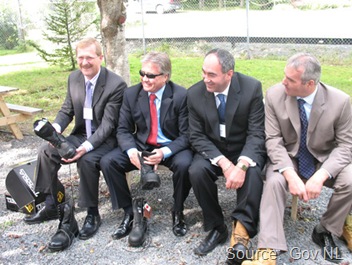Finance minister Tom Marshall today raised the spectre of 1933 and the collapse of Responsible Government in Newfoundland. He did so in the context of launching an attack on Liberal leader Gerry Reid based on Reid's comments in Labrador which Marshall took out of context. Marshall said the context was irrelevant, just saying the word bankruptcy was bad.
Marshall raises an interesting point for anyone looking at this campaign and wondering whether or not to vote, let alone decide which candidate to vote for. If the Telelink/NTV poll is any indication, that could be upwards of half the electorate.
The incumbent Tories make much of the supposedly poor financial state of the province in 2003. it was largely a fiction, as much as Marshall's claim that there was $305 million in the current budget from the 2005 offshore deal. That little myth has already been disposed of. There is no money in the budget from the 2005 deal; there is merely a set of numbers put on the paper to show the draw down on the cash advance. But this money has already been spent. it does not exist as new cash this year.
So what would it take to bankrupt the province? Let's take a look at two examples from the province's history when financial circumstances were indeed tight.
The 1933 Debacle
- $100 million in debt.
- $30 million in government revenue.
- $35 million gross domestic product.
- $3.5 million government budget shortfall.
A decade of political instability characterized as much as anything else by a remarkably familiar style of politics:
"Rival politicians … in the desire to secure election, were accustomed to make the wildest promises involving increased public expenditure in the constituency and the satisfaction of all the cherished desires of the inhabitants. The latter, as was natural, chose the candidate who promised them the most.
“…the electors in many cases preferred to vote for a candidate who was known to possess an aptitude for promoting his own interest at the public expense rather than for a man who disdained to adopt such a course.
“They argued that, if a man had proved himself capable of using his political opportunities to his personal advantage, he would be the better equipped to promote the advantage of his constituents; an honest man would only preach to them.”
Not a single provincial party in the current election is speaking of debt reduction. Rather there is talk of spending increases and, where anyone whispers the word, debt management. That is code for rolling over debt at cheaper interest rates or, as Danny Williams has said, actually borrowing more money on top of the $485 million in additional debt the government has incurred since 2003.
In 1933, the government debt was three times the size of the provincial economic output. The total government budget was slightly less than the economic output and the annual budget was short by $3.5 million or $10 percent of its total.
That was the state of the place when the legislature voted to accept an appoint commission government.
Using figures in Budget 2007, it would be virtually impossible to repeat that scenario in the current context even if every government for the next decade was completely insane. Canadian fiscal transfers would forestall bankruptcy or anything as dramatic as the 1933 situation and most likely action would be taken long before the provincial government put itself into the 1933 state again.
Just to put it in perspective consider that in order to come close to the 1933 mess, the provincial debt, on an accrual basis would have to reach upwards of $70 billion compared to the $11-12 billion currently. The annual provincial budget would have to reach spending of almost $20 billion annually, compared to the $22 billion current gross domestic product (approximate, using current dollars). The annual shortfall would have to be on the order of about $1.5 billion to $2.0 billion.
The early 1990s
- Provincial debt approaching $8.0 billion on an accrual basis, significant amounts held in high-priced foreign currencies.
- Provincial GDP of slightly more than $8.0 billion.
- Low oil prices. (US$8 in 1992 compared with forecasts of a decade earlier that oil would be well over $40 and may reach as high as $100)
- Low mineral prices (mineral prices are cyclical and are currently high)
- Declining fishery (followed by cod moratorium)
- Low Canadian dollar.
- Government spending on current account of $3.5 billion (approx.) with annual declines in revenue due to economic circumstances.
To match that situation, the provincial debt would have to reach the better part of $22 billion compared to the current $11-$12 billion. Government spending would run at about $9.0 to $10 billion, assuming that current account spending was about 43.75% of GDP and the annual deficit would be about $1.0 billion.
That situation is not as extreme as the 1933 scenario by any stretch. Mineral prices are cyclical and will likely drop in the next decade and remain low for a period. Likewise, and based on recent experience, oil prices may not continue at their current high levels. As for the fishery, its future economic performance is not guaranteed either, especially in light of global competition and declining resource in some sectors.
If we allow for energy corporation debt on existing projects of about $500 million (acquisition plus development costs, before revenue flows )and a Lower Churchill project of approximately $5.0 billion, the current provincial debt would reach about $17 billion.
As an aside, the Lower Churchill project website has now been taken over by NL Hydro. As a result background documents on the consultation process have vanished to dead links. Those dead links contained project cost estimates.
Taken altogether, the prospect of imminent bankruptcy for the province is remote. Even allowing for added debt over the next decade coupled with an economic downturn, it would almost impossible to conceive of a realistic scenario in which the 1933 situation recurred.
The situation in the early 1990s is not quite so remote but it would still take a concerted effort to undo the economic progress of the last 15 years.
The cost of developing the Lower Churchill and offshore projects would not decline significantly in the event of an economic downturn, for example, but resulting revenues would. As such it is possible to develop scenarios in which the provincial debt climbed to levels significantly above their current one, while at the same time, the size of the economy and resulting government revenues did not increase as dramatically or even declined.
Consider that Budget 2007 forecasts a decline in the provincial gross domestic product over the next three years while at the same time forecasting increases in government spending on the order of over nine percent in the same time frame.
This is a very rough comparison of two historic incidents with the current situation. No matter how one looks at it, the prospect of the province becoming bankrupt within the next decade is remote.
That's part of what makes Tom Marshall's comments odd. After all, if the provincial economy and government finances are so fragile that a mere $100 million of spending annually over a decade would break the treasury, his comments only raise questions about his own plans to borrow and spend considerably more than that in the same time frame.
-srbp-
![clip_image004_thumb[4] clip_image004_thumb[4]](http://lh5.ggpht.com/_1JCeohwjuLE/S7FKRz6YQZI/AAAAAAAACZs/GmVZFtqGU7E/clip_image004_thumb%5B4%5D_thumb%5B3%5D.jpg?imgmax=800)

 The provincial government communications people circulated a picture of the four at the time - from left, Jerome Kennedy, Danny Williams, Paul Oram, and Trevor Taylor – as they tried on some of the boots made at the plant. Every one is smiling. The $8.0 million in taxpayers’ cash was supposed to help the company add another 50 full-time jobs on top of the 170 at the plant.
The provincial government communications people circulated a picture of the four at the time - from left, Jerome Kennedy, Danny Williams, Paul Oram, and Trevor Taylor – as they tried on some of the boots made at the plant. Every one is smiling. The $8.0 million in taxpayers’ cash was supposed to help the company add another 50 full-time jobs on top of the 170 at the plant.